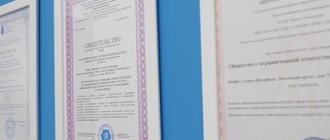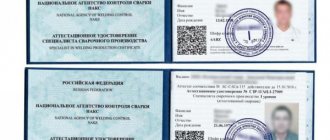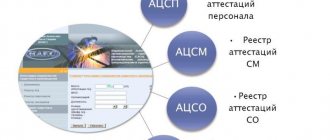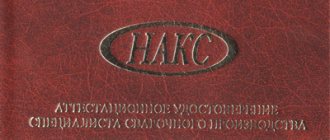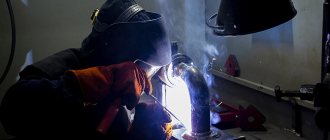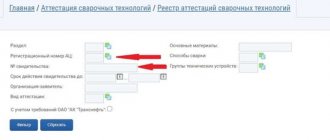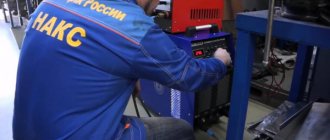When getting a job, certain categories of personnel are faced with the need to pass NAKS (welder certification).
Before taking the exams, it is worth studying what types of procedures exist. The requirements for the period of validity of the certificate and the types of work to which the employee will be allowed depend on this.
Definition of NAKS with varieties
This abbreviation refers to the national welding inspection agency. The institution is responsible for training welders, as well as engineers related to the creation of metal structures. A permit issued by NAKS increases the employee’s salary several times. There are the following types of certification:
- Primary. Conducted for employees who have not previously passed exams. The initiative comes both from the employee himself and from the enterprise fulfilling a special order or increasing the level of staff training.
- Repeated. Appointed upon expiration of the certificate.
- Extraordinary. It is carried out in relation to employees suspended from work due to technology violations.
- Additional. It is carried out if it is necessary to expand the list of types of work acceptable for an employee. Welders who have not worked in their specialty for more than 6 months undergo additional certification.
NAKS is the national welding inspection agency.
Depending on the type of acceptable work, certification is classified into:
- NAKS CO. This certification is required for employees performing welding work on boiler houses and pipelines operating at high temperatures. Maintenance of metal elements of heating equipment and protective devices is allowed.
- NAKS KSM. A certificate with this mark gives the right to perform welding work in the manufacture, maintenance or installation of steel bridges.
- NAKS NGDO. Employees are engaged in the installation and repair of oil and gas production equipment - pipelines, tanks for transporting and storing hydrocarbons, shut-off elements, drilling rigs, oil refining systems.
- NAKS OKHNVP (interpretation - equipment of petrochemical, fire and explosion hazardous enterprises). A welder with this type of certificate repairs elements operating under high pressure or vacuum conditions - pumps and compressors, furnaces, containers for storing flammable substances, boilers for recycling oil products, centrifuges.
- NAKS SK. Welding of metal building structures, reinforcement frames, and pipelines is allowed. In addition, a NAKS SK certificate is required for employees involved in the assembly of polymer elements.
We recommend reading: How to repair a gas tank using welding
Who needs training and certification of welders and NAKS specialists
Certification of welders and welding production specialists is carried out in order to establish the sufficiency of their theoretical and practical training, test their knowledge and skills and grant the right to welders and welding production specialists to perform work at facilities controlled by Rostechnadzor.
Where and how to get certified by NAKS?
Certification is carried out in any region of the Russian Federation, regardless of place of residence. It is organized on the basis of independent certification centers that are part of the NAKS structure. The exams are accepted by the certification commission.
Form of study
NAKS certification is not carried out remotely. To submit it, you must be present in person.
To obtain NAKS certification, specialists must first undergo pre-certification training.
Levels of welders and NAKS specialists and requirements for them
- NAKS welder certification level
I.
Required for welders. Gives permission to carry out welding work. Requirements
: secondary or incomplete secondary education + specialized courses, work experience - 6-12 months, depending on education. - NAKS specialist certification level II
.
Required by craftsmen. Allows you not only to perform work yourself, but also to control other welders. Requirements
: minimum secondary education, work experience – 6-36 months. - NAKS specialist certification level III
.
Required by technologists. Allows you to develop documentation related to the welding process and determine its technology. Requirements
: secondary technical education in welding production or higher technical education, work experience - 3-36 months. - NAKS specialist certification level IV
.
Required by engineers. Makes it possible to manage welding processes and approve the documentation according to which the work is being carried out. Requirements
: higher specialized education in welding production and additional preparatory courses.
Frequency of certification
The frequency depends on the level of the welder/specialist. NAKS documents for
:
- Level I welders are valid for 2 years;
- craftsmen and technologists of levels II and III - 3 years;
- level IV engineers - 5 years.
When the validity period of the certificate comes to an end, it is extended - periodic certification is carried out. To renew your NAKS welder certificate, you must submit documents no later than 1 month before its expiration date.
Types of NAKS certification
- Primary
. Needed by welders who previously did not have permission to weld or surfacing joints of equipment, structures and pipelines controlled by Rostechnadzor of the Russian Federation. - Additional
. Required for welders and welding production specialists who have had a break in work for at least 6-12 months (subject to performing the work specified in their certificates). And also for specialists who have passed the initial certification, but plan to perform work that is not recorded in the certificate. It is also carried out in case of updating the legislative acts of Rostechnadzor of the Russian Federation. - Periodic
. Required for welders whose certification is expiring. You can pass no more than two times, then you must take the primary certification again. - Extraordinary
. Needed by welders who have been removed from their duties due to technology violations or poor quality work. Can be carried out at the request of the employer or a representative of Rostechnadzor of the Russian Federation.
What do you get by completing training and certification by NAKS
- NAKS welder certificate of the established type
- Protocol of the certification commission
- Entry into the open Register of NAKS
Note! The certificate gives permission exclusively to perform the work specified in it.
Cost of NAKS certification for welders and specialists:
| Certification of welders level 1 (indicative) | from 15,000 rubles |
| Certification of specialists of levels 2 and 3 (indicative) | from 18,000 rubles |
The price of training depends on the chosen program, the number of certified welders/specialists and other factors. To clarify the cost, submit an application or contact the training center staff.
Necessary documents for training and certification of NAKS welders
Application.
Photocopy of passport.
A photocopy of the work book, certified by the seal and signature of the head of the enterprise.
A photocopy of medical certificate 086/U, certified by the seal and signature of the head of the enterprise.
Color matte photo 3x4.
A photocopy of the certificate/diploma of welding education for 4-5 categories, certified by the seal and signature of the management (for level I).
A photocopy of the NAKS certificate for level I (for certification at level II), for level II (for certification at level III).
Photocopy of the industrial safety protocol (for levels II and III).
Types and methods of welding
Melting/surfacing methods:
| Code (method) of melting/surfacing | Deciphering the method |
| RD | Manual arc welding with coated electrodes |
| RAD | Manual argon arc welding with non-consumable electrode |
| G | Gas welding |
| RDN | Manual arc surfacing with coated electrodes |
| Russian Far East | Bath manual arc welding with coated electrodes |
| MP | Mechanized welding with consumable electrode in active gases and mixtures |
| KTS | Contact spot welding |
| CSR | Flash butt welding |
| MF | Mechanized submerged arc welding |
| MPG | Mechanized welding with flux-cored wire in an active gas environment |
| Ministry of Railways | Mechanized welding with self-shielding flux-cored wire |
| MRSV | Bathroom mechanized welding with self-shielding flux-cored wire |
| IMF | Bath mechanized submerged arc welding |
| AF | Automatic submerged arc welding |
| NI | Welding polymer materials with a heated tool |
| ZN | Welding with embedded heaters of polymer materials |
Groups of OTD (hazardous technical devices):
| OTU Group Code | Decryption of the OTU group cipher |
| PTO | Lifting and transport equipment |
| CO | Boiler equipment |
| GO | Gas equipment |
| NGDO | Oil and gas production equipment |
| MO | Metallurgical equipment |
| OCNVP | Equipment for chemical, petrochemical, oil refining and explosion-hazardous industries |
| GDO | Mining equipment |
| OTOG | Equipment for the transportation of dangerous goods |
| SK | Building construction |
What is required to pass the exam
Before receiving a certificate, each welder undergoes the following procedures:
- Collects documents. The package includes a diploma of education, a certificate confirming the rank, a certificate of completion of a medical examination, 2 photos measuring 3 x 4 cm. Additionally, attach a document on completion of advanced training courses, if any.
- Provides papers to the nearest branch of the national agency, submits an application to take the exam. Pending review. The results are reported within 3 days by sending a written notification to the applicant. It indicates the date of the exam. If recertification is refused, the reasons must be stated.
- Passes the theoretical part of the exam. Most often it contains 20 questions.
- Performs practical work in the chosen field. Waiting for exam results. If certification is passed, a NAKS welder's certificate is issued within 2 weeks. The data is entered into an electronic database. If the exam is not passed, a second attempt is allowed after 1-6 months. In this case, the certification fee is paid again.
additional information
An enterprise always has a group of workers who are not subject to certification by NAKS. This list includes:
- specialists working under a fixed-term contract valid for up to 2 years;
- part-time workers;
- welder NAKS (master, technologist, engineer), who is taking advanced training courses;
- an employee who has passed the competition and has been working in a position for less than one year;
- young specialist.
Not all business managers understand that NAKS certification is an admission. If the employee does not have it, then he cannot be allowed to carry out welding work or control it. This is illegal. When conducting certification, inspection organizations must present their own permit, that is, permission to conduct inspections and exams.
Employee levels for certification
The classification of workers depends on the requirements for the actions they perform. There are 4 levels of certified employees:
- Electric and gas welder NAKS. An employee who has passed the exam and received a certificate is allowed to work in difficult areas. The welder makes structures from all metals in any spatial positions, engages in planing, melting, and cutting. It is necessary to be able to form seams of different configurations and make the right decisions in emergency situations.
- Master welder. Such an employee is subject to more stringent requirements. The master does not only welding. He supervises the work of other employees and gives them oral or written recommendations.
- Technologist. Controls all production processes related to welding.
- Engineer. Responsible for ensuring that welding production specialists comply with the rules governing work processes and compiles the appropriate documentation.
Where and how to get certified by NAKS?
So, you were required to undergo NAKS certification or you want to participate in a tender where there is a condition for having NAKS certification or you work at a hazardous production facility.
Where to begin?
First, you need to accurately determine the scope of certification. To do this, you need to find out what requirements are specified in the project or what requirements are set by the Customer. To do this, in accordance with Appendix 2 of Order No. 398a of June 9, 2008, determine a group of technical devices and select a specific list of technical devices included in the group (KO, GO, OKHNVP, NGDO, SK, etc.)
Now knowing which group of technical devices needs to be certified, you need to decide what type of welding the work will be performed with. (RD - manual arc welding, RAD - manual argon arc welding, AF - automatic submerged arc welding, etc.).
And the last of the main things is to understand what metal structures require certification - diameters, thicknesses. Next, you need to look at the design documentation for welding units.
Certification is divided into 4 subsections:
- Passing certification of welding production specialists (welders, foremen, foremen, engineers, chief welders) in accordance with PB-03-273-99 and RD 03-495-02,
- Passing certification of welding equipment in accordance with RD 03-614-03,
- Passing certification of welding materials, but this is not necessary since when purchasing welding materials it is necessary to require certification from the supplier.
- Passing NAKS certification for an organization performing welding work - certification of welding technology in accordance with RD 03-615-03.
The first thing that needs to be done is to certify the staff. You have welders who need to be certified at the NAKS certification center. To do this, you need to find a certification center in your region on the website naks.ru. Go to the website of the certification center and download an application for certification of a welder - welding production specialist of level I and an application for certification of an engineer and technical worker - welding production specialist of levels II, III and IV. The welder must have at least 4 categories.
How is certification carried out?
The procedure for taking the exams depends on who the procedure is for.
We recommend reading: How many categories do welders have?
For staff
At the first stage, the welder passes a practical exam. If the attempt is unsuccessful, the employee is not allowed to participate in the theoretical and special parts.
Retake is carried out no earlier than in a month. After this, the welder will be admitted to the remaining tests.
For production
When certifying an enterprise, the commission requires the following documents:
- technological map of welding production;
- instructions;
- certificates confirming the quality of the devices, materials, and tools used;
- agreement for periodic monitoring of NAKS;
- list of certified equipment;
- NAKS certificates of employees.
When issuing new or renewing old certificates, agency employees take into account the completeness of the equipment, compliance of technical data with the requirements specified in the passport, and the strength of the connections being formed. When considering an application, the quality of welding of two elements made of different metals is assessed. If it is high, the certification will be passed.
Certification levels
Why do you need a NAKS certificate? Today, its presence is a necessary condition for a specialist to perform welding work. The procedure and rules for certification that a welder undergoes are established by documents developed by NAKS. The procedure is carried out by certification centers, which are regional representative offices of NAKS. The certification commission includes certification experts who are certified and included in the NAKS register of experts, as well as representatives of Rostechnadzor. The received certificate confirms the professional level of the welder to perform specific work.
As part of the certification, the welder goes through several levels:
- Welder;
- Master welder;
- Welding technologist;
- Welding engineer.
Specialists of levels 2, 3 and 4, who are part of the management of enterprise divisions, must undergo mandatory certification. Specialists who need permission to work in hazardous or difficult conditions also undergo mandatory certification.
Procedure
The procedure for certification of welding equipment is carried out in the following sequence:
1. An application for inspection of welding equipment (WE) is submitted to the certification center. The addresses of the centers can be found on the official website of NAKS. 2. Along with the application, attach a copy of the product passport (if it is in a foreign language, then a translation is required), a warranty card, and a certificate from the manufacturer. 3. The equipment is brought to the certification center.
If the declared equipment is provided by a foreign company, documents confirming import into the country will be required. All copies of documents are certified by the head of the enterprise.
Depending on the amount of RM, types of certification of welding equipment are distinguished. This may be a check of one device, two or all available in production, as indicated in the application.
Certification of the certification body is carried out by establishing the accuracy of documents, compliance with the declared characteristics, and practical tests. The procedure is carried out in the following sequence:
1. An examination of the passport, certificate and other documents of the welding machine is carried out. 2. Certification of the CO includes the following tests: real characteristics of power, current, voltage, and load duration are assessed. 3. Welding connections are made and their strength is checked using destructive and non-destructive testing. 4. The test results are recorded in the protocol and a score is assigned to them. 5. An examination of the results is carried out. 6. A NAKS certificate is issued (if the equipment has passed the test).
The validity period of the welding equipment certification certificate (CO) is 3 years. The cost of certification of welding equipment depends on the number of devices provided for testing. Work with uncertified welding units will entail fines, the seams may be found to be of inadequate quality and everything will have to be redone, so it is better to immediately buy an inverter, semi-automatic device or TIG machine with a NAKS certificate.
What is needed to obtain a qualification certificate?
The enterprise or directly the person who needs to obtain a certificate submits the following documents:
- application for NAKS certification - it indicates specific types of work, types of equipment used;
- diploma confirming education;
- a copy of the work book;
- 2 photos.
After registering the application at the appointed time at the certification point, a practical task is issued. Representatives of Rostechnadzor must be present on the commission during the tests.
Many people wonder how to pass the NAKS and are worried about it. But if you have the appropriate skills and knowledge, there is no need to worry - the task corresponds to the types of welding work that were specified in the application. All you need is to perform high-quality welding and pass a theoretical exam.
The validity period of the received welder’s certificate is 2 years, that of a foreman and process engineer is 3 years, and that of a chief welder is 5 years. After this time, recertification is required. Certification can also be additional – if it is necessary to obtain permission for other types of work. There is also an unscheduled certification, which is assigned at the request of an authorized person for non-compliance with welding technology or low quality of welded joints.
- How to learn welding on your own?
- What electrodes should be used to cook stainless steel?
Certification of welders (I level)
To certify a welder, the organization the applicant provides:
- Application for certification
- Consent to the processing of personal data ( )
- Copy of document(s) on education (training)
- A copy of the qualification document (document confirming the qualification category or skill level) ( )
- Copy of work record book or certificate from place of work ( )
- A copy of the certification protocol or certification certificate of previous certifications (for additional or extraordinary certifications)
- A copy of the document confirming the absence of medical contraindications to work (in the Russian Federation) (outside the Russian Federation)
- Color photograph on matte paper, size 3x4 cm, 1 pc. for each welding method
To certify welders taking into account the requirements of documents of Transneft PJSC, in addition to applications, it is necessary to provide:
- medical certificate
- approval for electrical safety and labor protection
What does the agency control?
Organizations specializing in welding work will have to figure out what NAKS welding is, since clients will contact them with various types of work, including those of increased complexity. The costs of training your employees will be repaid by the high cost of carrying out difficult tasks.
In addition to licensing workers, the agency’s functions include:
- Development of guidelines and regulatory documents.
- Consultations on compliance with welding regulations.
- Development of internal policy of the organization.
- Formation of inspection commissions.
- Control of technologies and welding equipment.
A more precise definition of what NAKS is in welding is a coordinating center that determines a coherent control system in welding production. The qualification level under this system is higher. Those who have not passed the certification will not be allowed to perform complex work.
Certification of technologies is carried out to determine the compliance of the methods used with the requirements of GOSTs and other regulatory documents, including in the field of safety. Certification of the equipment used is required when carrying out work at sites with increased danger, for example, at high altitudes.
Welders levels
According to the NAKS system, there are four levels of professional training:
I is an ordinary welder. Must have a diploma and rank. Persons who have undergone professional training at courses, schools, or at their place of work are allowed for inspection. The minimum work experience in a specific type of welding varies from 6 to 12 months. II - master welder. Must have secondary technical education or higher education, undergo training in advanced training centers. With higher education, work experience is acceptable from 6 months. With an average - 9-36 months. III – welder-technologist. Persons with higher technical education in welding. Work experience from 6 to 12 months and level II certification. If there is no such certificate, the work experience must be 18-36 months. IV - welder-engineer. Persons with higher education in welding production. It is acceptable to not have a higher education diploma in welding if you have academic degrees (doctor, candidate) in technical sciences.

